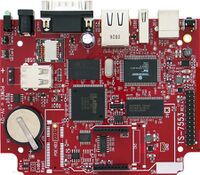TS-7553: Difference between revisions
(→Kernel) |
(→Kernel) |
||
| Line 104: | Line 104: | ||
=== Kernel === | === Kernel === | ||
The kernel is built based off the sources provided by Cavium. See the [[Cavium Kernel]] page for | The kernel is built based off the sources provided by Cavium. See the [[Cavium Kernel]] page for compiling information. | ||
== Hardware == | == Hardware == | ||
Revision as of 22:19, 5 June 2011
 | |
| Released Mar. 2010 | |
| Documentation | |
|---|---|
| Schematic | |
| Mechanical Drawing | |
| FTP Path |
Overview
The TS-7553 was released Mar. 2010 and is a smaller form factor and cost reduced version of the TS-7552 without the extra USB ports and 8-28V switching power supply. It was designed to be mated with an inexpensive plastic enclosure and serve as a standalone general purpose embedded server.
Features
- 250Mhz Cavium ARM9 CPU core (Faraday 526)
- 64MByte 16-bit wide DDR SDRAM running at 125Mhz
- 2 USB 2.0 High speed (480 Mb/s) Host ports
- 1 USB 2.0 slave port
- 1 TTL serial console port (16550) on CPU
- Hardware watchdog on FPGA
- Optional battery backed real time clock
- 10/100 Mbit on-CPU ethernet
- Low power (TS-7500 is 395mA @ 5V or 2.0 Watt)
- Fanless/heatsink-less operation up to 80C temperatures
- Customizable FPGA opencore (with Verilog sources)
- High speed SPI and I2C interfaces
- Standard CAN controller on DB9 connector
- Standard RS485 XUART serial port on DB9
- 2 RS232 XUART serial ports on DB9
- Optional onboard 802.11bg radio
- Onboard microSD socket
- 256Mbyte onboard XNAND Drive preloaded with Debian Linux
- 12 3.3V CPU/FPGA controlled GPIOs
- Designed to fit in a low cost plastic enclosure
Optional Features/Accessories
- CB-USB-AMBM: USB Cable w/ connectors USB-A Male to USB-B Male (can also used as power supply cable)
- CB-USB-AMAF: USB Cable w/ connectors USB-A Male to USB-A Female
- CB7-05: Null modem cable with a DB9F at each end
- RC-DB9: 10-pin header COM port adapter cable to DB-9
- TS-9448: Console Mini-Peripheral Board w/ 1 RC-DB9 cable
- WIFI-G-USB: USB 802.11g wireless network interface
- PS-5VDC-1AMP: 5VDC 1AMP Power Supply (100-240V)
- TS-ENC820: Plastic Enclosure
Getting Started
Get a console
If you have a TS-9448, you can connect that to the 26 pin header and use the DB9 port which will by default be the console port. If you do not have a 9448, you can hold the reset button for 5 seconds (until the red led lights up) and let go to switch the console port to the onboard COM port using the standard 8n1, no flow control, 115200 baud rate.
You can also telnet to the board with the default network configuration, though this will omit the TS-BOOTROM messages.
TS-Linux
After the board is first booted you will be at this shell:
Finished booting in 2.65 seconds Type 'tshelp' for help #
See the TS-Linux page on configuring the default boot options, including skipping TS-Linux. To boot into the full debian environment now, type 'exit' at the console.
Software
Boot Process
This board uses the TS-BOOTROM to load the OS. The SD Boot jumper, as well as the TS-9448 will decide where the system boots.
Boot Selection With TS-9448
| Switch Pos. | SDBOOT Jumper | Boot Behavior |
|---|---|---|
| Down | Off | XNAND |
| None | On | Offboard SPI Flash |
| Up | Off | MicroSD |
Note: JP1 will cause the bootloader to only boot to SPI Flash
Boot Selection Without TS-9448
| SDBOOT Jumper | Boot Behavior |
|---|---|
| Off | XNAND |
| On | MicroSD |
Kernel
The kernel is built based off the sources provided by Cavium. See the Cavium Kernel page for compiling information.
Hardware
Enclosures
The TS-7553 supports the TS-ENC820.